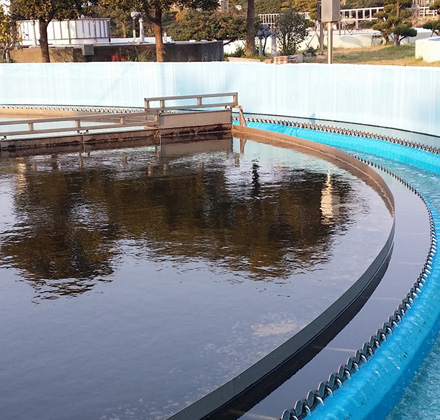Treatment of natural water and sewage is closely linked to preservation of the environment and is thus an actual present day problem. During the last decades there have been noticed substantial increase of the content of heavy metals, mineral oil, poorly-oxidable organic compounds, synthetic surfactants, pesticides and other pollutants from insufficiently treated effluents of industrial and municipal enterprises in open water reservoirs. In spite of the great number of elaborations reported in literature, the problem of natural water and sewage treatment has not yet been solved. Hence, the technology of water treatment needs further perfection which mainly includes the ways of intensive use of reagents, in particular flocculants. For these purposes water-soluble high-molecular compounds among which the most widespread and universal are polyacrylamide flocculants are used. As a result of their application the efficiency of removal of heavy metals is increased by 95%, compounds of phosphorus – by more than 90%, suspensions - by more than80%, organic substances - by more than 75%. Besides, flocculation water treatment is characterized by low capital and operational expenses as compared to the other methods of water treatment. A number of monographs and reviews are devoted to the problems of flocculation model and real disperse systems using polyacrylamide flocculants. In view of this information and taking into account the most significant latest data, the present review considers the basic patterns of treating natural waters and sewage with polyacrylamide(PАM) and its anionic and cationic derivatives in the presence and absence of mineral coagulants, as well as the most efficient ways of intensive water treatment
Polymers are useful as flocculants because they are robust molecules and sometimes carry charges. Because they are so large, small particles can get trapped in the curves of the polymer causing them to accumulate a mass heavy enough to prevent their retention in solution.
Several factors affect how flocculants work. By increasing the amount of kinetic energy in a solution through stirring or heating, flocculants have a faster impact on the particles. This phenomenon occurs because as kinetic energy is added to solution, particles move faster and therefore clump with the flocculants at a faster rate. The volume of solution and flocculants can also affect flocculation. Chances are, if a large amount of water is being cleaned, a larger amount of flocculants is needed. The most effective dose may also change depending on the flocculants type, which is often dictated by the available charges or size of the flocculants. Additionally, the water's pH can affect the performance of a flocculants. The pH scale (see Figure 7) is used to determine how acidic or basic the water is. Most flocculants work best at neutral conditions (pH 7) while some work independently of the PH.
